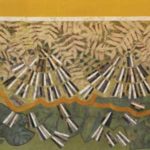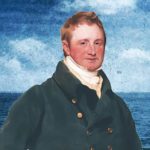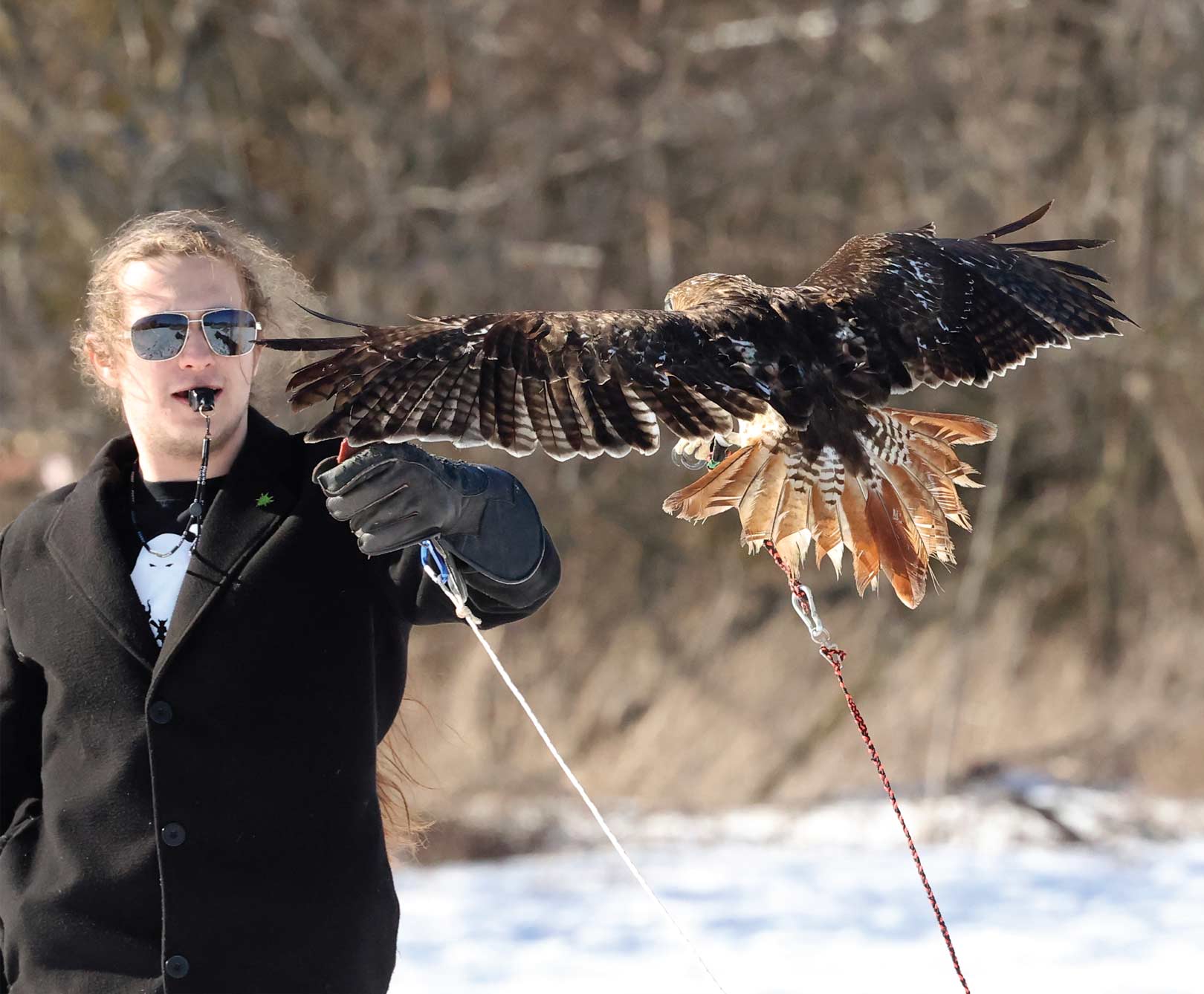
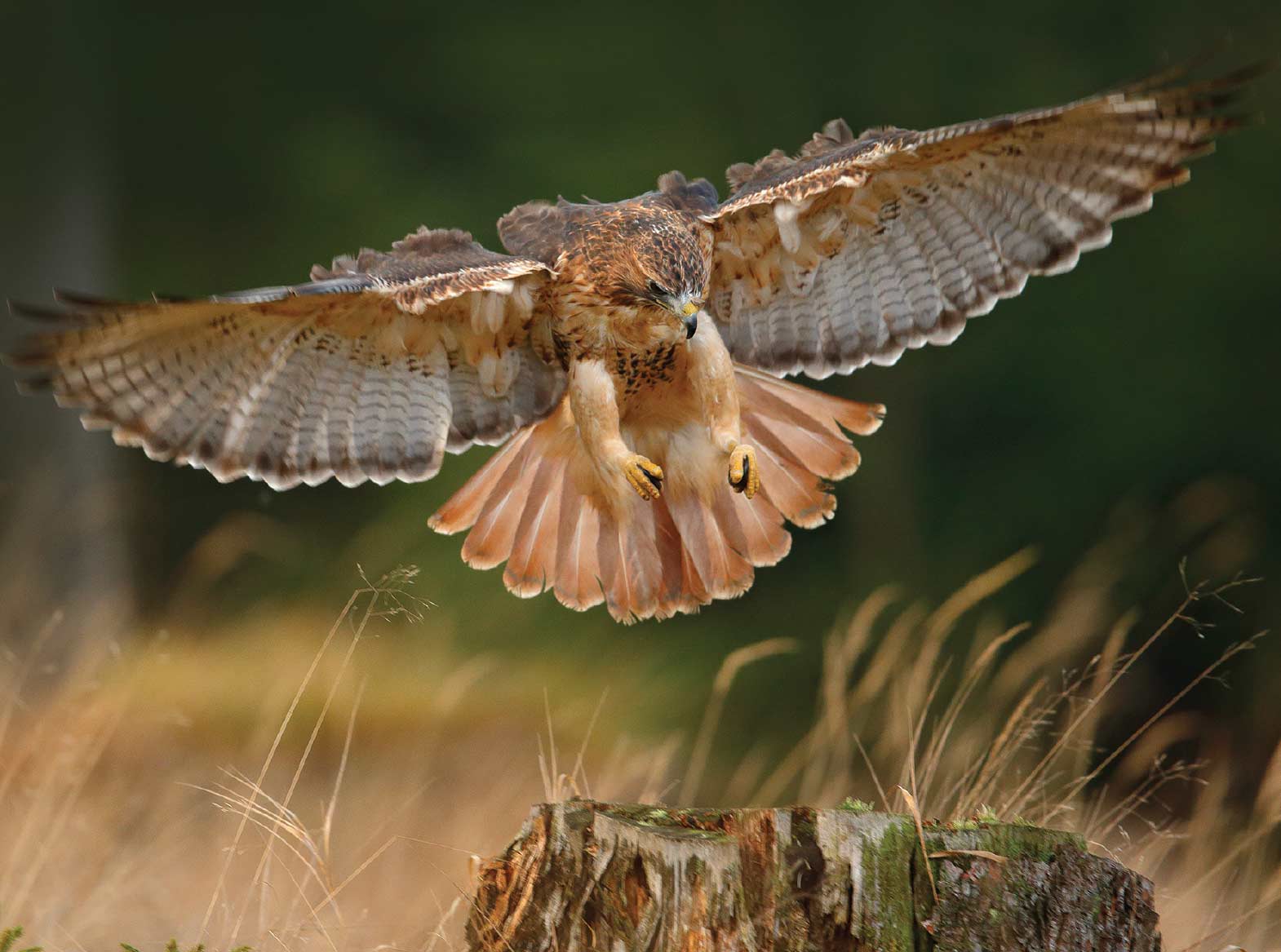
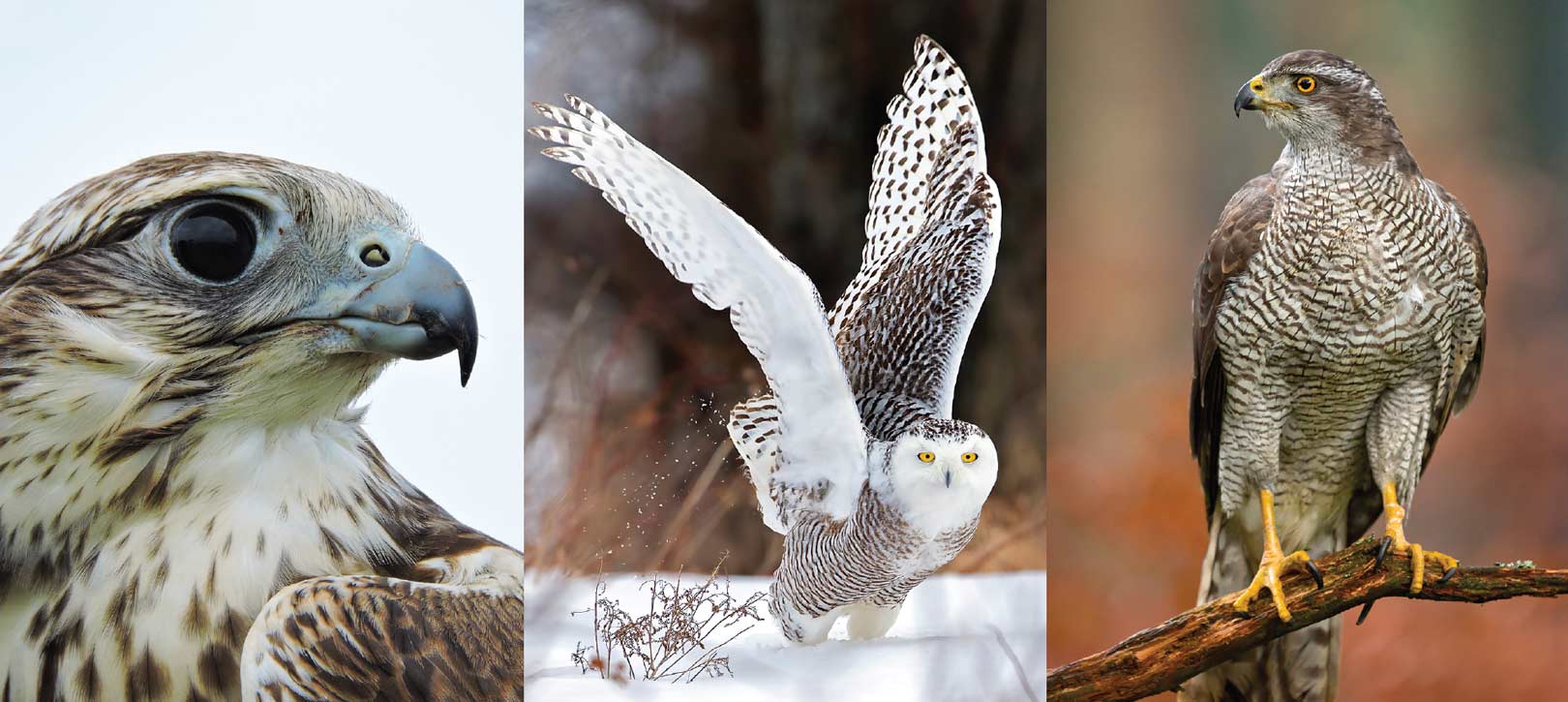
far left to right; red-tailed hawk; peregrine falcon, photograph by Montserrat; snowy owl; northern goshawk
The ancient sport of falconry is a passion that is soaring with new popularity
It is the last thing you expect to see as you stroll past market booths teeming with artisanal baked goods, and crafts – a majestic bird of prey wearing an embellished leather hood, calmly perched on the gloved hand of a young man. A few people look around to see if they’ve inadvertently stepped onto a film set. The falconer asks one of them if they want to hold the bird. As the hawk negotiates its way up the fascinated onlooker’s arm, all that stands between her and one of nature’s most powerful and elusive hunters is a thick leather glove.
Gryphon Nixon is a falconer in his twenties, and Val, (short for Valor), is a red-tailed hawk that is roughly the size of a forearm. Gryphon has been training and hunting with this spectacular raptor for two years, under the guidance of an expert falconer. Gryphon recalls the young bird in distress that started it all for him.
“I found an emaciated hawk sitting at my front door, preventing us from getting inside!” he says. “The wildlife rehabilitation centre nursed it back to health, and I had a chance to watch it being released back into the wild. It’s so rewarding. I knew I wanted to get into falconry after that.” And his life as a falconer took off.
Falconry is a broad term that involves training and hunting with these birds of prey, collectively known as raptors. Southern Ontario is home to eighteen different types of raptor: hawks like the Cooper’s hawk, northern goshawk and red-tailed hawk; more than eight different types of owls including the majestic snowy owl; falcons like the gyrfalcon and peregrine; turkey vultures; and eagles.
“Falconry takes a lot of dedication,” Gryphon explains. “You have to provide the bird with top conditions; you need to know and maintain their optimum weight, provide the best food, make sure they have a big enclosure where they can fly around. And even when you do all that, the bird never really bonds with you.”
Despite the time they have been together, he is quick to explain that Val is not a pet; raptors are first and foremost hunters. “If you bring them somewhere where there’s no prey, they’ll just sit around, or get anxious waiting for you to do something. They’ll be less likely to return to the glove when you call, and more likely to be aggressive and possibly lash out at you. It’s definitely not like caring for a dog. The most you can hope for is that the bird learns to trust you.”
Falconry hasn’t changed significantly in 4,000 years. It originated in the Middle East and was widely practised in Mongolia, China and Japan as a hunting method, but waned in popularity when guns came into use. It had a resurgence among the nobility in Medieval Europe as a “status sport” because keeping birds of prey was, and still is, labour intensive and costly. In modern times, however, beyond being featured in films about noble knights and a number of Saturday Night Live skits, falconry has been considered an ancient practice – until now.
The North American Falconers Association has reported a surge of new memberships, which has put them over the 2,000-member mark; and while the Ontario Hawking Club reports a more modest membership of a few hundred, what is common to these groups is the growing number of falconers under the age of 30. Falconers like Adam Baz, who goes by @hawkonhand has more than 38,000 Instagram followers; Shawn Hayes is featured on the Patagonia Films series, Game Hawker; and Lauren McGough’s @eaglefalconer has inspired countless women to take up the sport, garnering an impressive 22,000 followers. Their posts – complete with breathtaking images of soaring birds, remote landscapes and a “natural” lifestyle – are helping to shed falconry’s negative public image, making a direct connection between falconry and conservation efforts aimed at halting the loss of important wildlife habitats.
Gryphon agrees that educating the public about falconry practices is a step towards understanding how to help birds in the wild.
“I’m always myth-busting about keeping birds of prey and falconry. People think we’re being cruel to our birds when we put a hood over their head. But the hood is actually for the bird’s protection and helps us improve their hunting skills.”
He explains, “What the bird can’t see doesn’t exist. When we’re training young birds, the hood is used so they learn to focus their attention on ‘good prey’ instead of being distracted.” Falconers also place a custom-made hood on the birds in places with lots of people around so they don’t get too stressed.
The Ontario Ministry of Northern Development, Mines, Natural Resources and Forestry, which licenses and regulates falconry, recently expanded the number of wild raptors that can be “live captured.” There are strict regulations on the age, time of year, and best practices that must be followed, but falconers view the decision as an important step in recognizing the role they play in preservation efforts.
“What the bird can’t see doesn’t exist. When we’re training young birds, the hood is used so they learn to focus their attention on ‘good prey’ instead of being distracted.” GRYPHON NIXON
In fact, North American falconers are universally recognized for saving the peregrine falcon population. Thanks to their close observations of the birds’ nesting areas and hatchlings, they realized that something was making the eggshells so brittle that the mother bird’s weight was crushing the eggs when she was incubating them. Eggshell samples confirmed that large amounts of the pesticide DDT was causing calcium deficiency in the birds. To save the eggs from cracking prematurely, falconers took the unhatched eggs, replaced them with dummy eggs, and then put back the young when they were old enough. This, and other methods, helped the peregrine population rise from just 39 known pairs left in North America in 1970, to more than 2,000 pairs by 2018.
“Peregrines are incredible birds! They circle high and then ‘swoop’ – basically they power dive at 300 kilometres an hour … and thud! – the prey is killed on impact. Can you imagine the precision of that bird? It’s like nothing you have ever seen before,” says Gryphon.
He becomes even more animated discussing his “dream” hunting companion – the northern goshawk. “I would love to hunt with a goshawk. They hunt in the woods, weaving around trees at super speeds of 60 kilometres per hour! They were almost extinct, but falconers helped save them too,” he states. In Gryphon’s exhilaration when he talks about the hunt, you begin to understand the real draw. The wild bird does what it’s meant to do when it’s meant to do it, and the skilled falconer has worked very hard to earn enough trust to be deemed worthy of a front row seat.
If you are interested in helping local conservation efforts visit “Kestrel Nest Box Program.”
Story by:
Micol Marotti
Photography by:
James Scott



